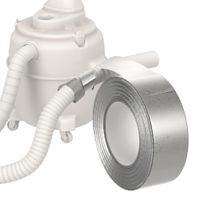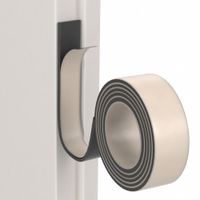Call +(254) 703 030 000 / 751 483 999 / 721 704 777
- Home
- Adhesives Sealants And Tape
- Tape
- Sealing Repair Tape
.....Read More
Frequently Asked Questions
What is sealing and repair tape used for?
Sealing and repair tape is a versatile adhesive product used for a variety of applications across different industries. It is primarily designed to create airtight and watertight seals, making it ideal for both temporary and permanent repairs.
In construction and home improvement, sealing tape is commonly used to seal joints, seams, and gaps in materials such as metal, plastic, and wood. It is often applied to roofs, windows, and doors to prevent air and water leaks, enhancing energy efficiency and protecting against weather damage.
In plumbing, repair tape is used to fix leaks in pipes and hoses. It can be wrapped around the damaged area to provide a quick and effective seal, preventing water from escaping and reducing the risk of further damage until a more permanent repair can be made.
In the automotive industry, sealing tape is used to repair hoses, patch leaks in radiators, and secure loose parts. Its heat-resistant properties make it suitable for use in engine compartments and other high-temperature environments.
In electronics, sealing tape is used to insulate wires and protect against moisture and dust, ensuring the longevity and reliability of electronic components.
In marine applications, sealing tape is used to repair boat hulls, seal deck fittings, and patch leaks in inflatable boats. Its resistance to saltwater and UV rays makes it suitable for use in harsh marine environments.
Overall, sealing and repair tape is a crucial tool for maintenance and emergency repairs, offering a quick, reliable, and cost-effective solution for sealing and protecting various surfaces and materials.
How do you apply sealing and repair tape?
1. **Surface Preparation**: Clean the area where the tape will be applied. Remove any dirt, dust, grease, or moisture to ensure proper adhesion. Use a cloth and a suitable cleaner if necessary.
2. **Measure and Cut**: Measure the length of tape needed to cover the damaged or leaking area. Cut the tape slightly longer than the required length to ensure complete coverage.
3. **Peel Backing**: Carefully peel off the backing from the tape. Avoid touching the adhesive side to maintain its stickiness.
4. **Application**: Align the tape with the area to be sealed or repaired. Press the tape firmly onto the surface, starting from one end and working your way to the other. Ensure there are no air bubbles or wrinkles.
5. **Smooth Out**: Use a roller or your fingers to smooth out the tape, applying even pressure to ensure a strong bond. Pay special attention to the edges to prevent lifting.
6. **Overlap (if necessary)**: If multiple strips are needed, overlap them by at least half an inch to ensure a watertight seal.
7. **Curing Time**: Allow the tape to cure as per the manufacturer's instructions. This may vary depending on the type of tape and environmental conditions.
8. **Test**: Once cured, test the repair by applying pressure or water to ensure the seal is effective.
9. **Maintenance**: Regularly check the repair to ensure the tape remains intact and effective. Reapply if necessary.
Can sealing and repair tape be used underwater?
Yes, sealing and repair tape can be used underwater, but it depends on the type of tape. Certain tapes are specifically designed for underwater applications, such as silicone or rubber-based tapes. These tapes are often self-fusing, meaning they bond to themselves when stretched and wrapped around a surface, creating a watertight seal. They are ideal for emergency repairs on pipes, hoses, and other surfaces submerged in water.
Another type of tape suitable for underwater use is butyl rubber tape, which is known for its strong adhesive properties and flexibility. It can adhere to wet surfaces and maintain a seal even under water pressure. Additionally, some epoxy-based repair tapes are designed to cure underwater, providing a durable and long-lasting repair solution.
When using sealing and repair tape underwater, it is crucial to ensure that the surface is as clean as possible to maximize adhesion. While these tapes are designed to work in wet conditions, removing any debris or loose particles will enhance their effectiveness.
It's important to note that not all sealing and repair tapes are suitable for underwater use. Standard duct tape or electrical tape, for example, will not provide a reliable seal when submerged. Always check the manufacturer's specifications to ensure the tape is rated for underwater applications.
In summary, while not all tapes are suitable for underwater use, specific types like silicone, rubber-based, butyl rubber, and certain epoxy tapes are designed for such conditions, providing effective sealing and repair solutions.
How long does sealing and repair tape last?
The longevity of sealing and repair tape depends on several factors, including the type of tape, the conditions of use, and the environment in which it is applied. Generally, high-quality sealing and repair tapes, such as those made from butyl rubber or silicone, can last anywhere from 5 to 20 years when used under optimal conditions.
Factors influencing the lifespan include:
1. **Material Quality**: Premium tapes made from durable materials like butyl or silicone tend to last longer due to their resistance to environmental factors.
2. **Environmental Conditions**: Exposure to UV rays, extreme temperatures, moisture, and chemicals can degrade the tape over time. Tapes used indoors or in mild climates typically last longer than those exposed to harsh outdoor conditions.
3. **Surface Preparation**: Proper surface cleaning and preparation before application can significantly enhance the tape's adhesion and longevity. Dirt, oil, or moisture on the surface can reduce the tape's effectiveness and lifespan.
4. **Application Method**: Correct application, including adequate pressure and overlap, ensures better adhesion and durability. Poor application can lead to premature failure.
5. **Load and Stress**: Tapes subjected to constant stress, movement, or heavy loads may wear out faster than those used in static applications.
6. **Maintenance**: Regular inspection and maintenance can extend the tape's life. Prompt repairs of any damage or wear can prevent further degradation.
In summary, while sealing and repair tape can last several years, its actual lifespan is contingent upon the quality of the tape, environmental exposure, and application conditions. Regular maintenance and proper application are key to maximizing its durability.
Is sealing and repair tape heat resistant?
Sealing and repair tape can be heat resistant, but it depends on the specific type and brand of tape. Many sealing and repair tapes are designed to withstand a range of temperatures, making them suitable for various applications, including those involving heat exposure.
For instance, some tapes are made from materials like silicone, aluminum foil, or specialized polymers that can endure high temperatures. These tapes are often used in automotive, HVAC, and industrial settings where heat resistance is crucial. Silicone tapes, for example, can typically withstand temperatures up to 500°F (260°C), while aluminum foil tapes can handle temperatures up to 600°F (316°C) or more, depending on the adhesive and backing material.
However, not all sealing and repair tapes are heat resistant. Standard duct tape, for example, is not designed for high-temperature applications and may fail when exposed to excessive heat. The adhesive can melt or lose its grip, and the backing material may degrade.
When selecting a sealing and repair tape for heat-resistant applications, it's essential to check the manufacturer's specifications regarding temperature tolerance. Look for tapes explicitly labeled as heat resistant or high-temperature, and ensure they meet the requirements of your specific application. Additionally, consider the environment in which the tape will be used, as factors like humidity, pressure, and exposure to chemicals can also affect performance.
In summary, while many sealing and repair tapes offer heat resistance, it's crucial to choose the right type for your needs by verifying the temperature ratings and material properties provided by the manufacturer.
Can sealing and repair tape be removed easily?
The ease of removing sealing and repair tape depends on several factors, including the type of tape, the surface it is applied to, and the duration it has been in place.
1. **Type of Tape**: Different tapes have varying adhesive strengths. For instance, duct tape and some heavy-duty repair tapes have strong adhesives designed for durability, making them more challenging to remove. In contrast, painter's tape or masking tape is designed for easy removal without leaving residue.
2. **Surface Material**: The material of the surface to which the tape is applied also affects removal. Non-porous surfaces like glass, metal, or smooth plastics generally allow for easier tape removal. Porous or textured surfaces, such as wood or fabric, may cause the tape to adhere more strongly, complicating removal.
3. **Duration of Application**: The longer the tape has been applied, the more difficult it may be to remove. Over time, adhesives can cure or harden, increasing their bond strength. Environmental factors like heat, sunlight, and moisture can also affect the adhesive, potentially making removal more challenging.
4. **Removal Techniques**: Proper techniques can facilitate easier removal. Using heat, such as a hairdryer, can soften the adhesive, making it easier to peel off. Solvents like rubbing alcohol or adhesive removers can help dissolve adhesive residue. Careful peeling at a 45-degree angle can also reduce the risk of leaving residue or damaging the surface.
In summary, while some sealing and repair tapes can be removed easily, others may require specific techniques or tools to ensure clean removal without damaging the underlying surface.
What surfaces can sealing and repair tape adhere to?
Sealing and repair tape is designed to adhere to a wide variety of surfaces, making it a versatile tool for numerous applications. It can stick to:
1. **Metal**: Ideal for sealing leaks in metal pipes, gutters, and roofs. It adheres well to aluminum, steel, and other metal surfaces.
2. **Plastic**: Suitable for repairing plastic pipes, containers, and other plastic items. It works on PVC, polyethylene, and other common plastics.
3. **Glass**: Can be used to seal cracks or breaks in glass windows, aquariums, and other glass surfaces.
4. **Wood**: Useful for temporary repairs on wooden surfaces, such as sealing leaks in wooden boats or covering cracks in wooden furniture.
5. **Rubber**: Effective for patching holes or tears in rubber hoses, tires, and other rubber materials.
6. **Concrete**: Can adhere to concrete surfaces for sealing cracks or joints, often used in basements or driveways.
7. **Fabric**: Suitable for repairing tears in fabric items like tents, awnings, and outdoor gear.
8. **Ceramic**: Can be used to seal cracks in ceramic tiles or pottery.
9. **Stone**: Adheres to stone surfaces for sealing or repair purposes, such as in stone countertops or decorative stonework.
10. **Fiberglass**: Useful for repairs on fiberglass boats, car bodies, and other fiberglass structures.
11. **Vinyl**: Can be used to repair vinyl siding, flooring, and other vinyl products.
12. **Leather**: Suitable for temporary repairs on leather goods like bags, jackets, and furniture.
The effectiveness of the tape depends on the surface's cleanliness, smoothness, and dryness. For optimal adhesion, surfaces should be free of dust, oil, and moisture.



